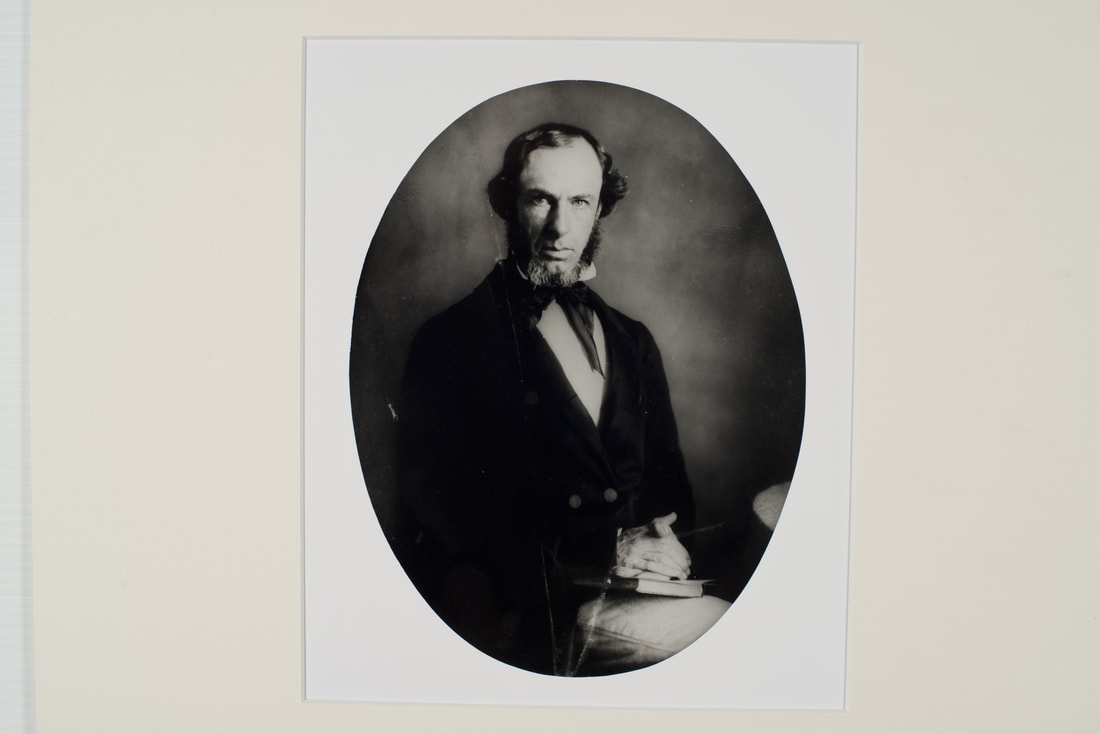Samuel Elyard at Jervis Bay Maritime Museum & Gallery
William Elyard, Surgeon Superintendent, and his family, including fourth son, four year old Samuel, arrived in Sydney in 1821 on board the John Bull, a female convict ship from Ireland, carrying 80 convicts and 22 free settlers. A few years after the family had settled in Sydney, in about 1826, Samuel was sent to Mr Gilchrist’s school where he was taught drawing by Edmund Edgar and showed an aptitude for art. By the age of nineteen he was teaching some drawing classes, taking on commissions and portraits and tried, unsuccessfully, to make a living as a professional artist. In 1837, he took up a position as a Clerk in the Colonial Secretary’s Office and as he wrote “There is not so much anxiety about this kind of life as there is in the profession of painting alone – consequently more of happiness. It is however an everyday sort of life.” He continued to paint and take commissions in his spare time.
After being taught drawing at Mr Gilchrist’s school in 1826, he attended John Dunmore Lang’s Australian College where, under J. B. East, he studied miniature and oil painting. At about this time he also took additional lessons with William Nicholas.
He also became acquainted with Conrad Martens, purchasing a number of Marten’s landscapes as well as painting his portrait. Along with Martens, the most significant influence appears to be John Skinner Prout, under whom he studied in the early 1840’s. Elyard’s preferred medium was watercolour and, like Prout, his preferred subject matters were picturesque buildings, street scenes and landscapes.
Elyard was an innovative artist and can be said to be an early starter in the use of a relatively new medium, and using quality watercolours painted on a very large scale; his panoramas are up to 130 cm in length. He painted en-plein-air years before this was common practice by Australian artists, who only regularly painted direct from nature from the 1880’s, and as he left England too young to remember or be influenced by the light and colours of the English landscape he could be said to be one of the first Australian artists to capture, in watercolour, the land, light and colours of Australia.
The Coastal Paintings
Samuel started visiting the Shoalhaven after his family had acquired property and one of his first visits, aged 17, was in January 1834 which is recorded in a small handmade diary titled “Sam’s trip to Shoalhaven”. By the age of nineteen he was teaching some drawing classes, taking on commissions and portraits and tried, unsuccessfully, to make a living as a professional artist. In 1837, he took up a position as a Clerk in the Colonial Secretary’s Office and as he wrote “There is not so much anxiety about this kind of life as there is in the profession of painting alone – consequently more of happiness. It is however an everyday sort of life.” Elyard continued to paint and take commissions in his spare time. However after 30 or so years in public service and numerous visits to family in the Shoalhaven, in 1868, due to ill health, he retired on a pension, and by March 1869 was living permanently at Nowra. This ‘forced’ retirement at age 51, to a quiet life in the Shoalhaven, was undoubtedly very good for his physical health and assisted in moderating his mental health issues; He lived another 42 years and died at 93 on 23 October 1910. Elyard’s retirement also resulted in an extremely beneficial artistic and historic legacy for the Shoalhaven, he was now able to spend time capturing favourite scenes and landscapes in his art. As indicated by the works that have been positively dated , the paintings in this exhibition are mainly from various trips to the Crookhaven, Cape St George, Jervis Bay and Wreck Bay areas during the 1870’s.
The Cape St George Paintings
The photograph of the lighthouse as it was, was probably taken by the artist on one of his several visits possibly during the 1890’s. Research suggests that the people pictured are Henry Gibson (Principal Keeper 1877 – 1899), William Parker ( Assistant keeper 1870 – 1899) and Edward Bailey (3rd Assistant Keeper 1882 – 1895 ) and their families.
Lighthouse as it is today : A review held after the lighthouse was completed in 1864, concluded that the lighthouse was built in the wrong place. There were multiple causes for the mistake, buck passing, confused decision making by the bureaucrats and the contractor seemed to have arbitrarily shifted the site to one closer to where they were quarrying the stone for the buildings, in an effort to save transport costs. Given this conclusion, it is still not understood why the decision was made to operate the lighthouse anyway. The end result was that ships travelling from the north could not see the light, and crucially those sailing from the South did not have clear vision of the light until it was too late to prevent mishap. During the time the lighthouse operated 1864 to 1899 there were 23 vessels wrecked in the area, though it must be said that not all these were directly attributable to the misplaced lighthouse.
Cape St George Lighthouse was shut down and replaced by the Point Perpendicular Lighthouse in 1899. In 1917 it was decided that Cape St George Lighthouse was still causing some confusion to sailors. When the tower was visible during the day or by moonlight, it could be mistaken for Point Perpendicular Lighthouse, so the Australian Navy came to the “rescue” and used the Lighthouse as target practice, hence the ruins that are seen today. On 24 June 2004 the ruins were listed on the Commonwealth Heritage Register.

 RSS Feed
RSS Feed